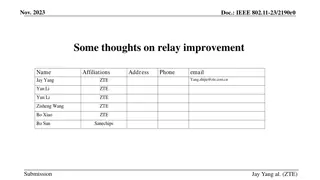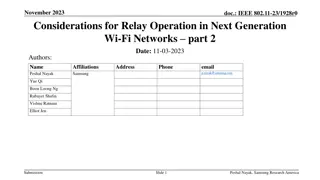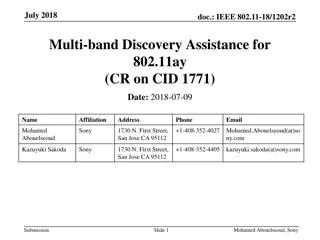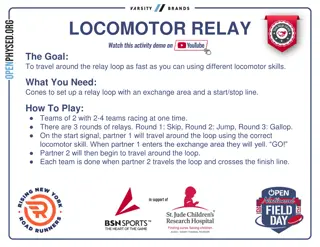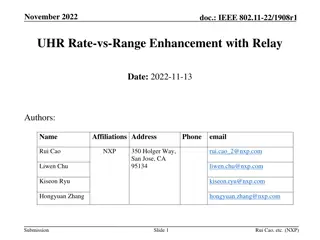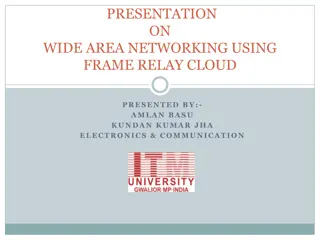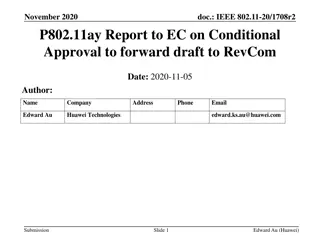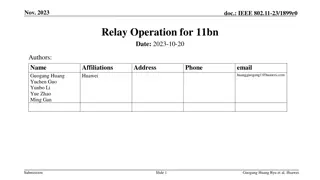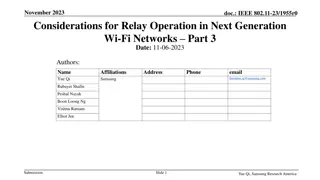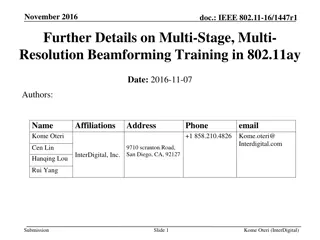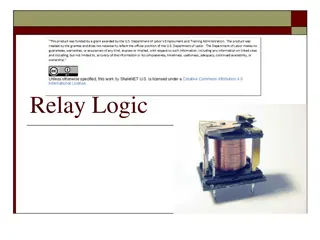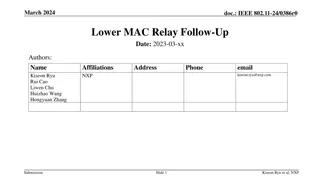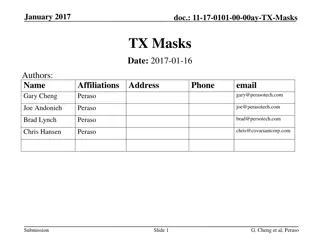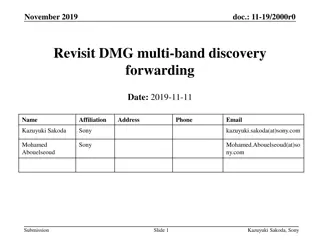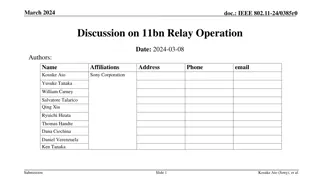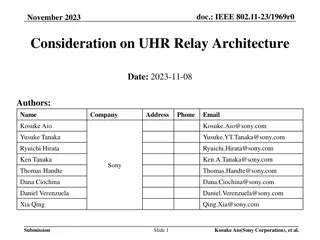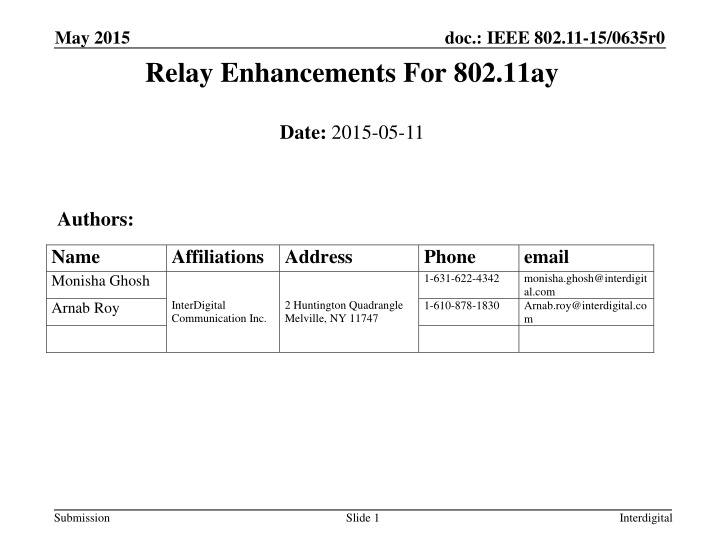
Enhancements for IEEE 802.11ay Relay in 802.11ad Specification
Explore relay enhancements proposed for IEEE 802.11ay within the 802.11ad specification, focusing on range extension and enabling bi-directional relay capability. The document reviews relay use, modes, and scenarios for range extension while highlighting the need for bi-directional data transmission to improve efficiency and throughput in wireless communication networks.
Uploaded on | 3 Views
Download Presentation

Please find below an Image/Link to download the presentation.
The content on the website is provided AS IS for your information and personal use only. It may not be sold, licensed, or shared on other websites without obtaining consent from the author. If you encounter any issues during the download, it is possible that the publisher has removed the file from their server.
You are allowed to download the files provided on this website for personal or commercial use, subject to the condition that they are used lawfully. All files are the property of their respective owners.
The content on the website is provided AS IS for your information and personal use only. It may not be sold, licensed, or shared on other websites without obtaining consent from the author.
E N D
Presentation Transcript
May 2015 doc.: IEEE 802.11-15/0635r0 Relay Enhancements For 802.11ay Date: 2015-05-11 Authors: Name Monisha Ghosh Affiliations Address InterDigital Communication Inc. Phone 1-631-622-4342 email monisha.ghosh@interdigit al.com Arnab.roy@interdigital.co m 2 Huntington Quadrangle Melville, NY 11747 1-610-878-1830 Arnab Roy Submission Slide 1 Interdigital
May 2015 doc.: IEEE 802.11-15/0635r0 Abstract This contribution briefly reviews the key features of the relay specification in 802.11ad and proposes two areas for enhancements: a) Range extension b) Bi-directional relay capability Submission Slide 2 Interdigital
May 2015 doc.: IEEE 802.11-15/0635r0 Relay Use in 802.11ad IEEE 802.11ad has support for directional relays. Relay links are seen as back-ups: utilized only when Source- Destination direct link fails. 802.11ad uses fixed 1st and 2nd Periods: channel times for Source- Relay and Relay-Destination data transfer are fixed. 802.11ad relaying procedure is unidirectional this could be optimized to enable efficient bi-directional data transfer. Submission Slide 3 Interdigital
May 2015 doc.: IEEE 802.11-15/0635r0 Relay modes in 802.11ad Two types of relay operation: Link Switching: R is used if S-D link is disrupted. Link Cooperating: S-D frame is simultaneously repeated by R: improves signal quality at D. Two modes are supported: FD/AF: Full-duplex/amplify-and-forward HD/DF: Half-duplex/decode-and-forward Relaying steps (some differences between Link Switching and Link Cooperating relay types): Relay setup procedures (common to both types) TPA (Transmission time-Point Adjustment) procedure (only Link Cooperating) SP request and allocation (different rules for FD/AF and HD/DF modes) Data/Frame exchange rules Submission Slide 4 Interdigital
May 2015 doc.: IEEE 802.11-15/0635r0 Range extension for relays Two scenarios could be considered: S-REDS and D-REDS are out of direct communication and control messaging range of each other S-REDS and D-REDS are out of direct communication range, but within control messaging range of each other The range extension scenario is shown in the following figure (only data coverage ranges are shown): Submission Slide 5 Interdigital
May 2015 doc.: IEEE 802.11-15/0635r0 Bi-directional data transmission The 802.11ad relay specification does not have a mechanism for the destination to initiate data transmission to the source using the same relay. Having this capability would enhance the efficiency and throughput and is an easy extension to the current specification. Fixed sized 1st and 2nd Periods impose some restrictions: Re-transmissions on one of the two hops requires use of a new 1st and 2nd Period pair. Transmissions in the reverse direction cannot be scheduled efficiently. A new relay channel access protocol is needed to increase efficiency for re-transmissions and bi-directional data transmission. Submission Slide 6 Interdigital
May 2015 doc.: IEEE 802.11-15/0635r0 Bi-directional data transmission Another 1st and 2nd Period pair is needed for re-transmission (S R transmission may be skipped since that was successful in first attempt) R D transmission is not successful Re-transmission inefficiency S R PSDU 1 R D PSDU 1 S R PSDU 1 R D PSDU 1 NOTE: First and Second Periods include ACK/B-ACK transmissions also (not shown here). First Period Second Period First Period Second Period No packets to send in reverse direction, unused channel time R D re-transmission is required, no reverse transmission (D R) possible Bi-directional transmission inefficiency PSDU A transmitted from D to R in previous cycle (not shown here) S R PSDU 1 D R PSDU B S R PSDU 2 S R PSDU 3 R S PSDU A R D PSDU 1 R S PSDU B R D PSDU 2 R D PSDU 3 R D PSDU 3 First Period Second Period First Period Second Period First Period Second Period Submission Slide 7 Interdigital
May 2015 doc.: IEEE 802.11-15/0635r0 Conclusions We highlighted two areas of the relay specification in 802.11ad that could be extended in 802.11ay to meet the requirements of some of the use cases under consideration. Submission Slide 8 Interdigital

